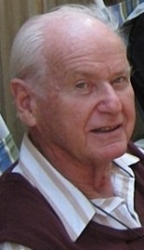

|

|
IN MEMORIAM
Thomas E. Mittler
Department of Entomological Sciences, Emeritus
UC Berkeley
1928-2012
Thomas Eduard Mittler was a member of the faculty of entomology at UC Berkeley from 1961 until his retirement in 1994. He was born March 13, 1928, in Vienna, Austria. At age 10, the 1938 Nazi Anschluss prompted his family to flee to England.
He received his B.Sc. in zoology with first class honors from Imperial College in 1949, and his Ph.D. in 1955 from the University of Cambridge under the guidance of the famous insect physiologist Vincent Wigglesworth. His research was concerned with the feeding and nutrition of sap-feeding insects, particularly aphids. An early discovery during his graduate work was that severing the needlelike mouthparts of the giant willow aphid during its feeding on plants allowed phloem sap to continue to flow out of the severed tubular feeding apparatus. This provided the purest form of phloem sap (the main liquid medium for translocating nutrients within plants) available at the time for plant physiologists to study.
The unusually complex life cycles of aphids provided endless opportunities to investigate another of his research interests, the influence of photoperiod and hormones on the polymorphism and sex determination of insects. His early work was in close collaboration with Dr. Reginald (Rex) Dadd, also a member of the Department of Entomology. Together, they established the first completely chemically defined artificial diets for aphids, deriving in no small measure from their discoveries of the chemistry of phloem sap. Aphids are among the most important of agricultural pests. Mittler and Dadds’ contributions to our basic understanding of aphid nutrition were widely cited by insect physiologists investigating aphid biology. They also established a fundamental base of information that, decades later, provided the foundation to better understand how microbial symbionts are essential for the growth and reproduction of aphids and vice versa. For aphids, the bacterial symbionts provide essential nutrients that enable the phenomenal growth rates of aphids. This symbiosis currently is probably our best documented and most convincing example of coevolution between separate organisms that form an obligate partnership.
Dr. Mittler also made major contributions as a consultant to the United Nations Food and Agriculture Organization in developing an artificial diet for studies on a major agricultural pest, the Mediterranean fruit fly. His laboratory attracted visiting scientists from all over the world and his research collaborations produced over 100 published articles. Included among these was a History of Entomology (1973), which he co-edited and which is largely still the main reference used on this topic.
Although technically a lecturer at UC Berkeley, his position was funded through the Agricultural Experiment Station and was functionally equivalent to professor. These positions reflect a former time and priority for the campus in that, although he directed the research of graduate students, he had no formal teaching requirements.
One of his major contributions was as editor of two major research journals. He edited Entomologia Experimentalis et Applicata for 20 years. This journal published primary research on a variety of entomological topics but was well known for its publications on insect physiology, Dr. Mittler’s specialty. His term as editor of the Annual Review of Entomology lasted for 32 years. His leadership of this journal was admirable, and to him his most significant accomplishment in the field of entomology. This journal only published one volume a year with 25-30 articles but the reviews by experts in their fields were the most cited of any entomological journal worldwide. Much of his efforts were spent finding and then convincing the world’s experts to prepare reviews on current topics of interest. He was universally regarded as both a diligent and a kind editor.
He married Bergliot (Tutten) Finsen in 1954. They had a long and happy life together until her death only a few months before his. They skied, ice danced, and traveled together extensively. He also enjoyed handiwork around his home and planning for their annual vacations in Tutten’s family home in Denmark, and in other countries to attend international meetings or visit colleagues. They have two sons, John and Eric, and one grandchild.
To us, Tom will always be remembered as a colleague who had the “milk of human kindness” flowing through his veins. He loved giving and attending parties, and was a great host of many that he held in their beautiful home in the Berkeley hills. One of his favorite toasts was “Once an entomologist, always an entomologist!” and he was always a friend of good cheer to all his students and colleagues.
Vincent H. Resh
Alexander Purcell
David Wood